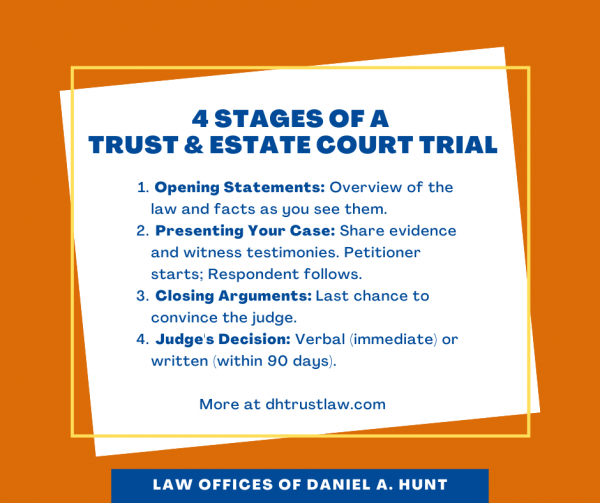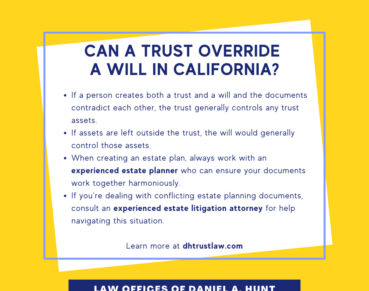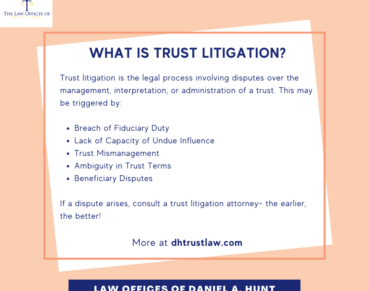What to Expect in a Trust & Estate Litigation Trial

If you’re a trustee or a beneficiary involved in a trust or estate conflict that is heading towards trial, you may be wondering what to expect in a trust & estate litigation trial. Will it be like an episode of “Law & Order”? Some aspects of your trial may be similar to what you’ve seen in movies or tv shows. But trust and estate cases are unique in some important ways from the criminal and civil cases often depicted in legal dramas. Before your trial begins, you should understand the format and stages of a trust and estate litigation trial.
Trust & Estate Litigation = Court Trial
Most legal dramas focus on criminal or civil legal cases. Both of these often utilize a “jury trial” format in which a group of peers hears the evidence and makes a decision at the end of the trial. By contrast, trust and estate cases are heard in probate court, which uses “court trials” or “bench trials”. In a court trial, a judge hears the evidence and makes a ruling. (The exception is elder abuse cases, which can use a jury.)
Decoding Trial Terminology
Before we explain what happens in a trust/estate litigation trial, it will be helpful to learn the correct terminology for both parties. The plaintiff (person bringing the case) is called “the Petitioner” since they are petitioning the court for assistance. The defendant (person being sued or accused of wrongdoing) is called “the Respondent”.
For example, in a trust or will contest, the Petitioner is usually the party challenging the validity of the document and the Respondent is defending the document’s validity.
4 Stages of a Trust & Estate Litigation Trial
A typical court trial contains 4 main elements: opening statements, witness testimonies and introduction of evidence, and finally closing arguments.
Step 1: Opening Statements
The trial starts with each side offering an opening statement. Each opening statement presents an overview of the case facts as that party sees them. Your opening statement should stick to the case facts and your theory of the case. The goal is to depict your position as reasonable, logical, and legally sound so that the judge will side with you.
Step 2: Presenting Your Case
After opening statements, the Petitioner will present their case first. This may include evidence collected during the discovery process, such as written answers to questions they’ve asked the opposition; relevant documents they’ve obtained, written admissions from the opposition that certain facts are true; physical evidence obtained via subpoena; and deposition transcripts from interviews with the other party or a third party. These are all typically presented through the use of witnesses.
The Petitioner starts by calling their first witness for direct examination. The Petitioner’s attorney will ask the witness questions designed to draw out relevant case facts. Once the direct examination ends, the Respondent’s attorney can cross-examine the witness, challenging parts of their testimony or trying to elicit additional facts previously omitted. The Petitioner’s attorney can then rehabilitate their witness after the cross-examination.
Once the Petitioner has called their last witness and finished presenting evidence, the Petitioner will rest their case. If the court decides that the Petitioner hasn’t met “their burden of proof” (meaning they presented insufficient supporting evidence), the judge in rare cases may decide in favor of the Respondent without requiring them to present a defense. But if the Petitioner has presented sufficient evidence to make a case, then the Respondent must now present their case and call their own witnesses.
Rest assured that attorney-client privilege protects any communications you have had with your attorney regarding the case. That information cannot be presented as evidence in a court trial.
Step 3: Closing Arguments
After both parties have finished presenting their cases, the trial concludes with closing arguments. A closing statement should be very persuasive, as this is your last chance to convince the judge that your side should win.
Step 4: Judge’s Decision
Finally, the judge will make their ruling on the case issues. The judge may give a verbal ruling on the spot, or will “take the case under submission” and issue a decision within 90 days. Our next blog post will explain what comes after trial.
If your case is heading to trial, you’ll want an experienced trust and estate litigator on your side. If you have any questions about the litigation process, feel free to contact our law firm.
Law Offices of Daniel A. Hunt
The Law Offices of Daniel A. Hunt is a California law firm specializing in Estate Planning; Trust Administration & Litigation; Probate; and Conservatorships. We've helped over 10,000 clients find peace of mind. We serve clients throughout the greater Sacramento region and the state of California.




